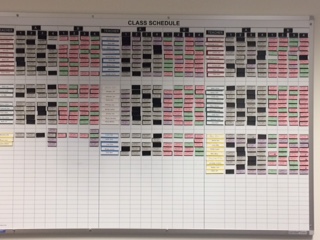Inside L-S: The cartography of the master course map
In February, students receive their course selection sheets. By August, they receive their schedules. Behind the scenes, a lot happens between those two times that defines what exactly the school will offer, in what periods, and with what teachers.
After all the course selections have been entered into PowerSchool, Mr. Eric Spencer begins the process of devising the master schedule by compiling a tally sheet that breaks down how many students requested each course. He shares this tally sheet with each department head, who then suggests how many sections of each course should run. After a dialogue and ultimate consensus, he loads a preliminary master schedule into the computer.
Spencer has found that hand building Advanced Placement (AP) and other single-section courses helps maximize the number of students who are able to fit them into their schedules. At the AP level, offerings by subject area are grouped by period (e.g., all science AP courses in first period, AP English and HACC English in second period, etc.).
"A handful of kids try to double up," he says, "but most students will only take one in a subject."
Spencer estimates that from March until May, he spends at least two hours each day working on building a schedule that works best for all involved. This often includes eight to ten "runs" of the system that builds individual student schedules. He says that 95-98% of students have schedules that align with the courses they selected.
In some cases, though, students have to make choices or sacrifices. Sometimes, courses do not run due to too few students signing up. This year, that happened with AP Calculus BC (which roughly equates to "Calc II" at the college level). Only eight students signed up, and the schedule would not have been able to accommodate all eight taking it; with limited staff resources, Spencer determined it was not feasible to offer the course in the building, much to the disappointment of Kevin Reed, a senior who is planning an engineering career and requested the course. Ultimately, Reed and two other students were able to take the course online through a third-party provider.
"I was always told that the college track for math classes was all the way to BC Calc," says Reed, "so it was extremely frustrating when I was told that instead of making a small AP class, I would take an online course where I don't have a teacher who can explain concepts any faster than over email."
Fortunately, though, not being able to get into a desired course is a rare case Spencer says happens to less than 50 students per year. Ensuring that remains the case undoubtedly ranks near the top of his priorities for the final few months of his tenure at L-S.
Editor's Note: The co-author of this piece (BP) is another of the students taking AP Calculus BC online. Kevin Reed's quote in the article represents his opinion, and is not an official position of LSNews.org.
--Benjamin Pontz, LSNews.org Editor-In-Chief and Justin Burkett, LSNews.org Managing Editor; Photo by Lauren Mast, LSNews.org Staff Photographer
 |
| The "master course schedule" board in Mr. Spencer's office |
Spencer has found that hand building Advanced Placement (AP) and other single-section courses helps maximize the number of students who are able to fit them into their schedules. At the AP level, offerings by subject area are grouped by period (e.g., all science AP courses in first period, AP English and HACC English in second period, etc.).
"A handful of kids try to double up," he says, "but most students will only take one in a subject."
Spencer estimates that from March until May, he spends at least two hours each day working on building a schedule that works best for all involved. This often includes eight to ten "runs" of the system that builds individual student schedules. He says that 95-98% of students have schedules that align with the courses they selected.
In some cases, though, students have to make choices or sacrifices. Sometimes, courses do not run due to too few students signing up. This year, that happened with AP Calculus BC (which roughly equates to "Calc II" at the college level). Only eight students signed up, and the schedule would not have been able to accommodate all eight taking it; with limited staff resources, Spencer determined it was not feasible to offer the course in the building, much to the disappointment of Kevin Reed, a senior who is planning an engineering career and requested the course. Ultimately, Reed and two other students were able to take the course online through a third-party provider.
"I was always told that the college track for math classes was all the way to BC Calc," says Reed, "so it was extremely frustrating when I was told that instead of making a small AP class, I would take an online course where I don't have a teacher who can explain concepts any faster than over email."
Fortunately, though, not being able to get into a desired course is a rare case Spencer says happens to less than 50 students per year. Ensuring that remains the case undoubtedly ranks near the top of his priorities for the final few months of his tenure at L-S.
Editor's Note: The co-author of this piece (BP) is another of the students taking AP Calculus BC online. Kevin Reed's quote in the article represents his opinion, and is not an official position of LSNews.org.
--Benjamin Pontz, LSNews.org Editor-In-Chief and Justin Burkett, LSNews.org Managing Editor; Photo by Lauren Mast, LSNews.org Staff Photographer


